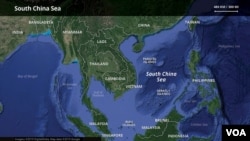Tension is rising again in the South China Sea following two collisions Sunday between vessels from the Philippines and China near the Second Thomas Shoal, a disputed reef situated within Manila’s exclusive economic zone.
The collisions took place as Manila was carrying out a resupply mission to the Sierra Madre, a World War II-era warship that Manila intentionally grounded at the Second Thomas Shoal as a military outpost to safeguard its territorial claim.
Both sides issued strongly worded statements to criticize the other and released videos to support their accusations. On Monday, the Philippines summoned the Chinese ambassador to express its position on the disputed reef.
“Ayungin Shoal is part of our exclusive economic zone and continental shelf and we have sovereign rights and jurisdiction over it,” said Teresita Daza, the spokesperson of the Philippine Foreign Ministry, using the Philippine name for the shoal. She characterized the Chinese Coast Guard’s actions as “illegal, dangerous, provocative and deplorable.”
In response, China’s Foreign Ministry issued a statement Sunday, accusing the Philippine vessels of intruding in the waters of “Ren’ai Jiao,” the Chinese term for Second Thomas Shoal, and “bumped dangerously with” Chinese Coast Guard ships on the scene. The spokesperson urged the Philippines to take China’s concerns seriously, “stop stirring up trouble and making provocations at sea.”
Some analysts say the latest incident between China and the Philippines, which follows a series of confrontations between the two sides in recent months, reflects a growing degree of aggression from Beijing in the disputed water at a time when the U.S. is distracted by wars in the Middle East and Ukraine.
“The Chinese might have sensed an opportunity to test to what extent will the U.S. be able to help the Philippines push back against the Chinese in the South China Sea at a time when the U.S. is so invested in the Middle East conflict,” Collin Koh, a defense scholar at Singapore's S. Rajaratnam School of International Studies, told VOA by phone.
Water cannons, blockade
The latest confrontation comes after the Philippine military accused Chinese coast guard ships of spraying Philippine vessels with water cannons during a resupply mission to Sierra Madre in August. It also follows another confrontation between Philippine and Chinese vessels near the Second Thomas Shoal earlier this month, during which the Philippine vessels reportedly broke an attempted blockade imposed by Chinese coast guard ships.
Some experts say Beijing may think the Philippines would be deterred from defending its territorial claims to the disputed reefs in the South China Sea after Chinese coast guard ships used a range of aggressive tactics to disrupt Manila’s resupply missions.
“China thought the Philippines [would] realize that they were overmatched and needed to take a more submissive approach, but the Philippines continued to release evidence [of Beijing’s aggressive actions],” said Ray Powell with the Gordian Knot Center for National Security Innovation at Stanford University.
He said the Philippines’ decision to consistently release images and videos of the Chinese coast guard’s interception of the Philippines’ resupply mission to the Second Thomas Shoal has generated more international support for Manila, which is reflected through statements released by other countries, including the U.S.
“The U.S. now consistently refers to the mutual defense treaty when talking about the West Philippine Sea,” he told VOA by phone. “Governments in the Western world have come in a very strong way and some of this support is becoming material. [These countries] are now talking about joint patrols and there are also discussions about how high the Philippines would climb on the list of countries that will receive international military assistance.”
Following the incident Sunday, the U.S., Japan, Australia, and the U.K. all released statements to condemn China’s behavior near the Second Thomas Shoal. The U.S. State Department said the Chinese coast guard and maritime militia “violated international law by intentionally interfering with the Philippine vessels’ exercise of high seas freedom of navigation.”
Testing Washington’s resolve
Despite the statements of support from allies, Koh in Singapore thinks the U.S. needs to fulfill its promises of offering support to the Philippines through concrete actions because China is likely to keep testing Washington’s red line.
“If the Americans don’t seem to be doing more than what they are doing now, it may signal incorrectly to the Chinese that they are succeeding in pushing the envelope,” he told VOA. “The Chinese will likely push it even further. The Americans have to be concerned about their credibility.”
While Beijing has been increasing its aggression near the disputed reefs in recent months, Koh thinks China is not prepared to use forces against the Philippines.
“The ramming and water cannon are common tactics used by the Chinese, and we are not seeing signs of a full-fledged escalation,” he said, adding that Beijing’s calculation will depend on Washington’s response.
But as both Beijing and Manila are doubling down on their efforts to defend their territorial claims, with the Chinese coast guard imposing blockades to disrupt the Philippines’ resupply missions and the Philippine military force deploying larger vessels to escort the mission, some analysts fear that the two sides are locked in a “spiraling escalation.”
“Over the past few weeks, both China and the Philippines are pressured to double down on their actions, and they are locked in this spiral of escalation, which is very hard to untangle,” Justin Baquisal, a Manila-based geopolitical analyst, told VOA by phone.
Instead of simply challenging the Philippines’ determination to stick to its current approach, Baquisal thinks Beijing is ultimately testing Washington’s resolve. “China is deliberately doing this to see if the U.S. is willing to open up a third front of its conflict,” he said, adding that these attempts are stretching Washington’s logistics thin.












